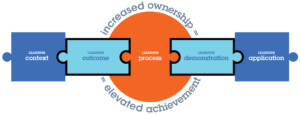Share this article.
We at Elevated Achievement believe that in order for each and every learner to achieve at higher levels they must own their learning. We believe that learners can be taught to own their learning. And, we have said this before, but it cannot be stated enough: We believe that learning should not be exclusive to our students. Its power is expanded when there is a community of adults who have the skills necessary to elevate student achievement. In other words, we believe all adults in a student’s community must actively engage in professional learning opportunities that ultimately will benefit the student.
That’s we wrote this series of articles for all educators who believe in building a learning community. And now this is the perfect time to provide the knowledge and tools school-site administrators and/or presenters need to implement a focused Learning Model for Adults for each and every professional learning session they provide to staff, teachers, and parents and caregivers.
In other articles, we provided an overview of the Learning Model for Adults and its five phases: setting the Learning Context, stating the Learning Outcome, engaging in the Learning Process, producing the Learning Demonstration, and implementing the Learning Application. We also discussed the planning sequence and provided examples of professional learning sessions that elevate student achievement.
In this article, we take an in-depth look at two of the five phases that engage adults in learning and lead to elevated achievement, the Learning Outcome and its counterpart Learning Demonstration.
Determining the Learning Outcome
This is the phase of the session during which adult learners specifically understand what they will be learning and the demonstration of their learning. During this phase, the presenter explains WHAT learners will learn and HOW they will show ability or apply what they have learned. Adult learners will struggle with the learning if they are not clear how to answer the question, “What will I learn?”
While stating the Learning Outcome, the learning can be written in a variety of ways—as a learning intention with success criteria, as a learning goal, as an objective, or as one part of a larger unit. The learning outcome should be stated, written, discussed, or addressed as determined by adult learner needs. Learners will have the opportunity to produce or demonstrate mastery of the session outcomes during Learning Demonstration.
The Value of Knowing the Learning Outcome
If adult learners know what they are learning, they are more motivated to…
- Construct personal meaning and a deep understanding of what they are learning.
- Connect the learning to increased student achievement.
- Ensure that the learning is implemented and supportive of student success.
In other words, the value is having a session of adult learners who will supported in and committed to elevating student achievement. Instead of just one teacher, students will have a community of support.
To help you make stronger learner-centered decisions, consider these questions as you plan:
- What will the participants learn?
- What will the participants do to show that they have mastered the learning?
- How will you share this information with your participants?
Producing the Learning Demonstration
This is the phase of the session during which adult learners show mastery of the outcomes of the session. Learners will need to understand what successful learning looks like and sounds like if they are to answer the question, “How will I show that I have learned it?”
While producing the Learning Demonstration, the presenter describes what adult learners need to demonstrate to show mastery of the session’s learning, why this shows mastery, and the criteria for success. Much of this information was first explained in Learning Outcome.
The Value of Producing the Learning Demonstration
If adult learners know how they will know when they are learning, they are more motivated to…
- Take an active role in shaping and using their learning to students’ benefit.
- Connect the learning to increased student achievement.
- Ensure that the learning is implemented and supportive of student success.
In other words, the value is having a session of adult learners who will supported in and committed to elevating student achievement. Instead of just one teacher, students will have a community of support.
To help you make stronger learner-centered decisions, consider these questions as you plan:
- What will the participants do to show that they have mastered the learning?
- How will this demonstrate that they met the learning outcome?
- How will you share this information with your participants?
Keep Developing Learnership
As we’ve said before, students deserve a community of adults committed to learning skills that will increase student achievement. Therefore, it is critical for presenters to deliberately make the decisions that will increase adults’ engagement in learning and overall motivation. The best decision a presenter can make is to utilize a focused Learning Model for Adults when planning professional learning sessions.
That’s why we are providing these articles that take in-depth looks at the each of the phases of the Learning Model for Adults, their value to student achievement, and the planning questions and tools needed for implementation. The following sequence for reading is recommended as you plan with a focused Learning Model for Adults.
- First, make sure you’ve read the article, “How to Motivate Adult Learners with the ‘Why’ and the ‘How’” so you know how to determine the Learning Context and the Learning Application. In other words, read this article to get the planning questions and tools you need to determine why the learning is important to adult learners and how they will use it in the future.
- Next, read this current article to learn how to determine the Learning Outcome and the Learning Demonstration. In other words, read this article to get the planning questions and tools you need to determine the specific skills adult learners are learning and what a demonstration of mastery will look and sound like.
- Finally, read “How to Actively Engage Adult Learners in the Learning Process” to learn how to determine the Learning Process. In other words, read that article to get the planning questions and tools you need to determine the instructional strategy or strategies that will allow adult learners to most effectively and efficiently demonstrate mastery of the learning outcome.
Then you’ll be ready to backward plan a session and deliver instruction throughout that session with the end in mind as you move through the five phases: setting the Learning Context, stating the Learning Outcome, engaging in the Learning Process, producing the Learning Demonstration, and implementing the Learning Application.
Continue the Learning
Check out these articles and resources to continue your learning about this topic…
The Learning Brief
In this article you learned…
- The Learning Outcome is the phase of the session during which adult learners specifically understand what they will be learning and how they will show they have learned it.
- The Learning Demonstration is the phase of the session during which adult learners produce work that shows they have mastered the session’s learning.
- Adult learners who know what they are learning something and how they will know they’ve learned it, construct personal meaning and deep understanding of what they are learning, take an active role in shaping and using their learning and connect the learning to increased student achievement, and ensure that the learning is implemented and supportive of student success.
Can you imagine building an environment full of motivated, engaged, and eager students who own their learning?
We can.


